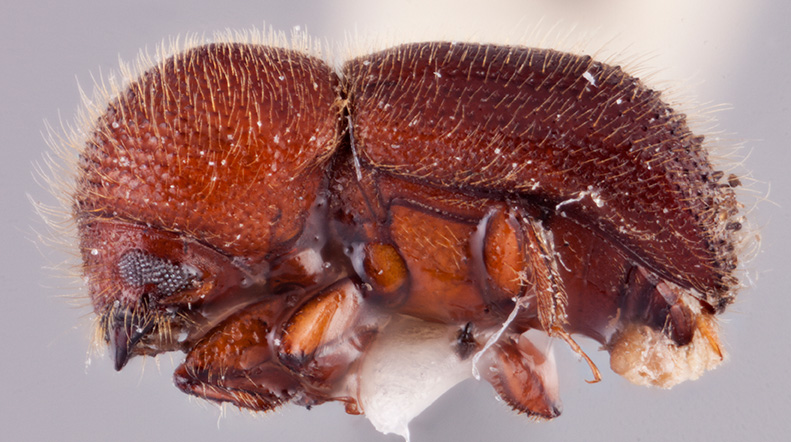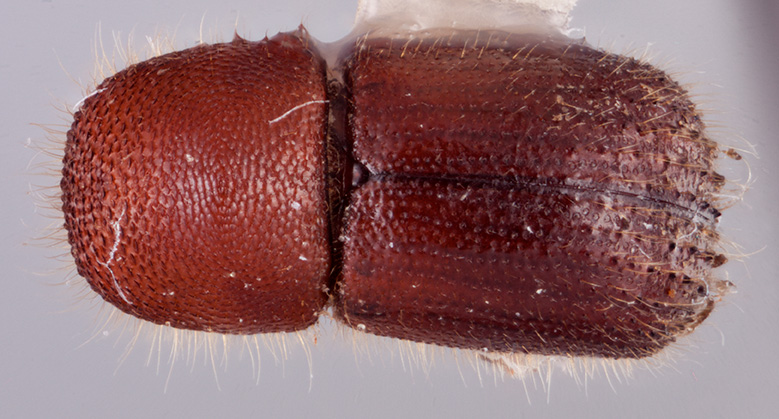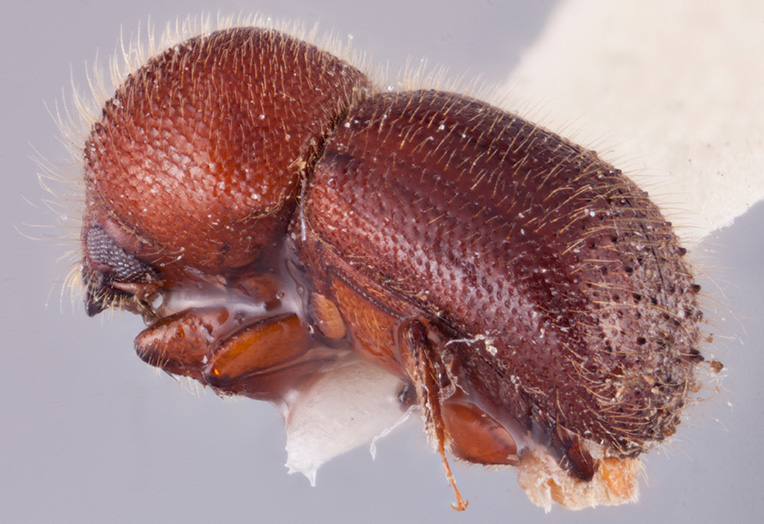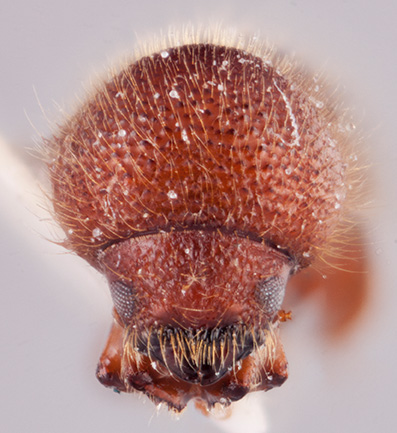Ambrosiodmus minor
|
Ambrosiodmus minor lateral; R.K. Osborn |
|
Ambrosiodmus minor dorsal; R.K. Osborn |
|
Ambrosiodmus minor declivity; R.K. Osborn |
|
Ambrosiodmus minor frontal; R.K. Osborn |
Taxonomic history
Phloeosinus minor Stebbing, 1907: 37.
Dryocoetes minor (Stebbing): Stebbing, 1914: 549.
Xyleborus minor (Stebbing): Beeson, 1930: 70.
Ambrosiodmus minor (Stebbing): Wood and Bright, 1992: 676.
Synonyms
Xyleborus crassus Hagedorn, 1910a: 8. Schedl, 1962a: 208.
Diagnosis
3.5−4.0 mm long (mean = 3.74 mm; n = 5); 2.19−2.53 times as long as wide. This species can be distinguished by each declivitaldeclivital:
pertaining to the elytral declivity
interstria variously tuberculate, never granulategranulate:
pertaining to a coarse, grainy surface texture
 ; and red-brown color.
; and red-brown color.
This species strongly resembles A. lewisi from which it can usually be distinguished by the smaller size and tuberclestubercle:
a small knob-like or rounded protuberance of the exoskeleton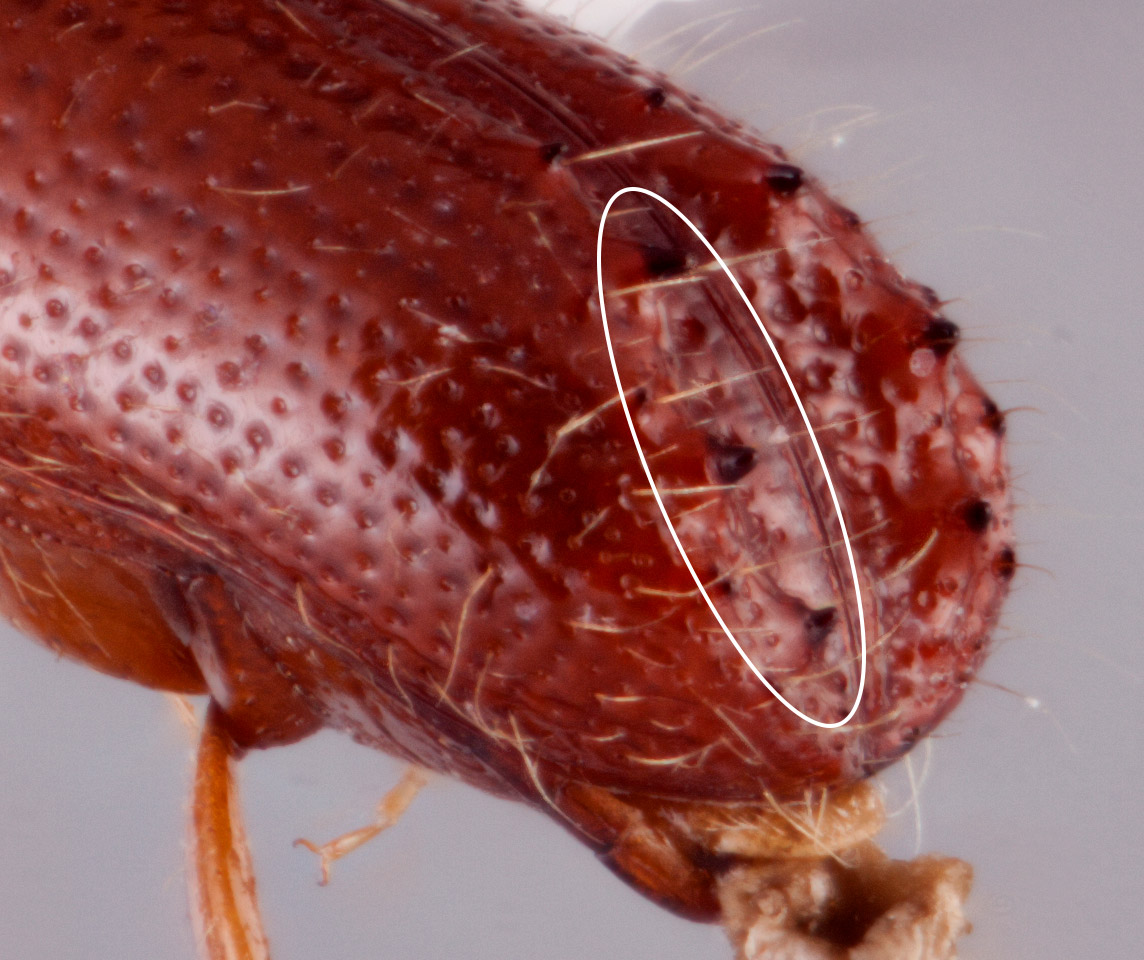 on interstriaeinterstria:
on interstriaeinterstria:
longitudinal spaces along the elytra between the striae, which is not as<br />
impressed and bear smaller punctures.
 2 not distinctly larger than those of other interstriaeinterstria:
2 not distinctly larger than those of other interstriaeinterstria:
longitudinal spaces along the elytra between the striae, which is not as<br />
impressed and bear smaller punctures.
 .
.
May be confused with
Distribution
Bangladesh, Bhutan, China (Chongqing, Guangxi, Jiangsu, Jiangxi, Sichuan, Yunnan, Zhejiang), India (Assam, Meghalaya, Madhya Pradesh, Maharashtra, Sikkim, Uttarakhand, Uttar Pradesh, West Bengal), Laos, East Malaysia, Myanmar, Nepal, Taiwan, Thailand, Vietnam. Established in the USA (Rabaglia and Okins 2011Rabaglia and Okins 2011:
Rabaglia RJ, Okins KE. 2011. Entomology section. Tri-ology 50 (3): 6-9.; Gomez et al. 2018aGomez et al. 2018a:
Gomez DF, Rabaglia RJ, Fairbanks KEO, Hulcr J. 2018a. North American Xyleborini north of Mexico: a review and key to genera and species (Coleoptera, Curculionidae, Scolytinae). ZooKeys 768: 19-68. https://doi.org/10.3897/zookeys.768.24697).
Host plants
polyphagous (Beeson 1930Beeson 1930:
Beeson CFC. 1930. The biology of the genus Xyleborus , with more new species. Indian Forest Records 14: 209-272., Beeson 1961Beeson 1961:
Beeson CFC. 1961. The ecology and control of the forest insects of India and the neighbouring countries. 2nd edition. Government of India, New Delhi, 767 pp., Ohno 1990Ohno 1990:
Ohno S. 1990. The Scolytidae and Platypodidae (Coleoptera) from Borneo found in logs at Nagoya port 1. Research Bulletin of the Plant Protection Service, Japan 26: 83-94., Maiti and Saha 2004Maiti and Saha 2004:
Maiti PK, Saha N. 2004. Fauna of India and the adjacent countries. Scolytidae: Coleoptera (bark and ambrosia beetles). Vol. 1. Part 1. Zoological Survey of India, Kolkata, 268 pp.)
Remarks
Wood and Bright (1992) considered the species as being described by Stebbing in 1909 (Stebbing, 1909: 20) and rather than in 1907 despite listing this publication under the taxonomy section for the species. This error undoubtedly occurred because Stebbing classified Phloeosinus minor as a new species in both publications. However in 1909 he states “this amplifies the description given of this insect in [1907]” at the end of the species description. This error has been unknowingly perpetuated throughout the literature published since 1992.
DNA data
Sequences available for COI and CAD.

